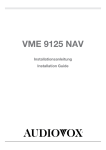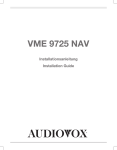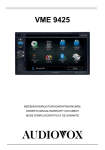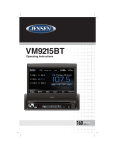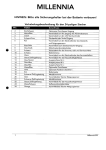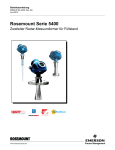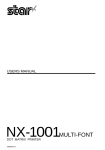Download Audiovox VME 9425 Installation guide
Transcript
VME 9425 Installationsanleitung Installation Guide ® 3 5 Anschlussdiagramm/ Wiring Diagram 7 Lieferumfang Benötigte Werkzeuge und Materialien: • VME 9425 Receiver • 2-DIN-Montageklammern für linke und rechte Seite • 2-DIN-Montagerahmen • Zierblende • Beutel mit Zubehör • ISO-Adapterkabel für Lautsprecher und Stromversorgung • Anschlusskabel • Externes Mikrofon • Bedienungsanleitung • Installationsanleitung • Kabelbaum für NAV104 • Torx-, Schlitz- und Kreuz-Schraubendreher • Seitenschneider und Abisolierzange • Werkzeug zum Herausnehmen des eingebauten Radios (Schraubendreher, Steckschlüsselsatz oder andere Werkzeuge) • Isolierband • Crimpzange • Spannungsmesser/Stromprüfer • Crimpverbindungen • 18-adriges Anschlusskabel • 16- bis 18-adriges Lautsprecherkabel Optionales Zubehör • NAV 104 Navigationsmodul. Alle Montage- und Bedienungsanweisungen sind im Lieferumfang des Navigationsmoduls enthalten. • Rückfahrkamera Abklemmen der Batterie Schalten Sie vor der Montage des Geräts die Zündung ab, und lösen Sie das Kabel vom Minuspol (-) der Batterie, um einen Kurzschluss zu vermeiden HINWEIS: Wenn das VME 9425 in ein Fahrzeug eingebaut werden soll, das mit einem Navigationssystem ausgestattet ist, lösen Sie das Batteriekabel nicht. Andernfalls gehen die im Speicher des Navigationssystems abgelegten Daten unter Umständen verloren. In diesem Fall sollten Sie bei der Montage allerdings besonders vorsichtig sein, um einen Kurzschluss zu vermeiden. Austauschen der Sicherung Achten Sie beim Auswechseln der Sicherung darauf, dass Sie eine neue Sicherung mit 15 A verwenden. Durch den Einsatz einer falschen Sicherung kann das Gerät beschädigt oder ein Brand verursacht werden. ISO-DIN-Installation Dieses Gerät ist für den Einbau in einen 2.0-DIN-Armaturenschacht vorgesehen, der in vielen Importfahrzeugen vorhanden ist. Das Gerät verfügt auf den Gehäuseseiten über Bohrungen mit Gewinde, die für die Original-Montageklammern mancher Fahrzeuge von Toyota, Nissan, Mitsubishi, Isuzu, Hyundai und Honda zur Montage des Radios im Armaturenbrett verwendet werden können. Bitte wenden Sie sich an einen lokalen Fachbetrieb für Stereogeräte für Fahrzeuge, wenn Sie Hilfe bei dieser Montage benötigen. 1.Entfernen Sie das Original-Radio aus dem Armaturenbrett bzw. der Mittelkonsole. Bewahren Sie alle Teile und Klammern auf, da diese für die Montage des neuen Radios erforderlich sind. 2.Bringen Sie die Original-Haltevorrichtungen sowie das Montagezubehör des alten Radios am neuen Radio an. VORSICHT: Verwenden Sie keine Schrauben, die größer als M5x6 mm sind. Durch längere Schrauben werden unter Umständen Komponenten im Inneren des Gehäuses berührt und beschädigt. 3.Halten Sie das Radio vor die Öffnung im Armaturenbrett, sodass die Verkabelung durch das Armaturenbrett geführt werden kann. Beachten Sie das Schaltbild und stellen Sie sicher, dass alle Verbindungen mithilfe von Kabelsicherungen oder Isolierband geschützt und isoliert sind. Wenn die Verkabelung abgeschlossen ist, verbinden Sie die ISO-Steckverbinder mit den entsprechenden Anschlüssen auf der Rückseite des Gehäuses. Schalten Sie das Gerät ein, um die Funktion zu prüfen (die Zündung des Fahrzeugs muss eingeschaltet sein). Kann das Gerät nicht eingeschaltet werden, überprüfen Sie die Verkabelung, bis Sie den Fehler gefunden haben. 4.Montieren Sie das neue Radio im Armaturenbrett oder in der Mittelkonsole, indem Sie die in Schritt 1 beschriebenen Arbeiten in umgekehrter Reihenfolge ausführen ACHTUNG! Achten Sie darauf, dass die Fahrzeugverkabelung nicht beschädigt wird. EJE CT HINWEIS: Der Endbenutzer ist dafür verantwortlich, die Montage und den Betrieb des Geräts entsprechend den Gesetzen der Region und des Landes sicherzustellen. Das Kabel der HANDBREMSE muss wie in der Bedienungsanleitung angegeben angeschlossen werden. ACHTUNG: Die Lüftungsschlitze dürfen nicht verdeckt werden, da das Gerät ansonsten überhitzen und so beschädigt werden kann. ACHTUNG! Installieren Sie das Gerät so, dass die Fahrsicherheit nicht beeinträchtigt wird. 3 Installation unter Verwendung des Montagerahmens Step 1-b 1. Montage des Montagerahmens in das Armaturenbrett. a. Montieren Sie wenn nötig den Adapter (nicht im Lieferumfang enthalten). b. Montieren Sie den Montagerahmen in das Armaturenbrett oder ggf. in einen Adapter (verwenden Sie dazu ausschließlich die mitgelieferten Schrauben). Drücken Sie das Gehäuse nicht gewaltsam in die Öffnung, und achten Sie darauf, dass es sich nicht verbiegt oder verformt. ACHTUNG! Schließen Sie das Gerät nur an eine Stromquelle mit 12 Volt an und stellen Sie dabei eine ordnungsgemäße Erdung sicher. Step 1-c c. Oben, unten und seitlich am Gehäuse befinden sich Metalllaschen. Wenn das Gehäuse vollständig in die Öffnung des Armaturenbretts geschoben wurde, biegen Sie so viele Laschen wie erforderlich nach außen, damit das Gehäuse fest im Armaturenbrett sitzt. 2. V erwenden Sie die mitgelieferten M5x6 Schrauben, um die Befestigungsbügel unter Verwendung der im Diagramm gezeigten Löcher an beiden Seiten des Radios zu befestigen. Verwenden Sie keine anderen Schrauben. 3. Halten Sie das Radio vor die Öffnung im Armaturenbrett, sodass die Verkabelung durch das Armaturenbrett geführt werden kann TAB DASHBOARD Step 2 4. N ehmen Sie die Verkabelung wie im Anschlussdiagramm dargestellt vor. Schließen Sie dann das gelöste Batteriekabel wieder an. Ist kein ACC-Anschluss (Zündleitung) verfügbar, schließen Sie das ACC-Kabel mit einem Schalter an die Stromversorgung an. ACHTUNG! Achten Sie darauf, dass die Fahrzeugverkabelung nicht beschädigt wird. 5. N achdem Sie alle Kabel angeschlossen haben, schalten Sie das Gerät ein, um sicherzustellen, dass es betriebsbereit ist. Beachten Sie dabei, dass dieZündung eingeschaltet sein muss. Kann das Gerät nicht eingeschaltet werden, überprüfen Sie die Verkabelung, bis Sie den Fehler gefunden haben. Sobald das Gerät betriebsbereit ist, schalten Sie die Zündung aus und montieren das Chassis. a.Schließen Sie den Kabeladapter an den vorhandenen Kabelbaum an. b.Schließen Sie das Antennenkabel an. c.Schieben Sie das Radio vorsichtig in den Montagerahmen, und achten Sie darauf, dass die richtige Seite nach oben zeigt. Verwenden Sie die mitgelieferten Schrauben, um das Radio am Montagerahmen zu befestigen. Step 5-c Verwendung der Zierblende Im Lieferumfang ist eine Zierblende enthalten, um die Montageflexibilität zu erhöhen. Der Receiver passt in das Armaturenbrett der meisten Importfahrzeuge, ohne das Armaturenbrett bzw. den Einbauschacht zu verändern. Das Armaturenbrett mancher Fahrzeuge für den USamerikanischen Markt ist für ein DIN-Doppelgehäuse geeignet, jedoch bleibt nach dem Einbau zwischen dem Radio unddem Armaturenbrett ein kleiner Spalt. Verwenden Sie in diesem Fall die passende Zierblende, um einen möglichen Spalt zu verdecken. HINWEIS: Für den ordnungsgemäßen Betrieb des CD/DVD-Players muss das Chassis waagerecht mit einer maximalen Abweichung von 30° montiert werden. Achten Sie darauf, dass dieser Richtwert eingehalten wird. 4 TRIM RING MOUNTING SLEEVE What’s in the Box Tools and Supplies • VME 9425 Head Unit • Left and Right Double DIN Mounting Brackets • Double DIN Half Sleeve Install Bracket • Custom Cosmetic Trim Ring • Hardware Bag • Speaker Output Harness • Power Input Harness • Accessory Harness • External Microphone • Owner’s Manual • Installation Guide • NAV 104 Interface Harness You will need these tools and supplies for installation: • Torx type, flat-head and Philips screwdrivers • Wire cutters and strippers • Tools to remove existing radio (screw driver, socket wrench set or other tools) • Electrical tape • Crimping tool • Volt meter/test light • Crimp connections • 18 gauge wire for power connections • 16 – 18 gauge speaker wire Optional Equipment • NAV 104: Allows you to access navigation features. All installation and operating instructions are included with the navigation module. • Rear Camera Disconnecting the Battery To prevent a short circuit, be sure to turn off the ignition and remove the negative (-) battery cable prior to installation. NOTE: If the VME 9425 is to be installed in a car equipped with an on-board drive or navigation computer, do not disconnect the battery cable. If the cable is disconnected, the computer memory may be lost. Under these conditions, use extra caution during installation to avoid causing a short circuit. Replacing the Fuse When replacing the fuse, use a new 15A replacement fuse. Using a fuse with an improper rating could damage the unit and cause a fire. ISO-DIN Installation This unit is designed to fit into a 2.0 DIN dashboard opening, found in many imported cars. The unit has threaded holes in the chassis side panels which may be used with the original factory mounting brackets of some Toyota, Nissan, Mitsubishi, Isuzu, Hyundai and Honda vehicles to mount the radio to the dashboard. Please consult with your local car stereo specialty shop for assistance on this type of installation. 1. R emove the existing factory radio from the dashboard or center console mounting. Save all hardware and brackets as they will be used to mount the new radio. 2. Remove the factory mounting brackets and hardware from the existing radio and attach them to the new radio. CAUTION! Do not exceed M5 X 6MM screw size. Longer screws may damage components inside the chassis. 3. Place the radio in front of the dashboard opening so the wiring can be brought through the mounting sleeve. Follow the wiring diagram carefully and make certain all connections are secure and insulated with wire nuts or electrical tape. After completing the wiring connections, plug the ISO connectors into the mating sockets on the rear of the chassis. Turn the unit on to confirm operation (vehicle ignition switch must be “on”). If the unit does not operate, re-check all wiring until the problem is corrected. 4. Mount the new radio assembly to the dashboard or center console using the reverse procedure in step 1. CAUTION! Be careful not to damage the car wiring. EJE CT NOTE: It is the end-users responsibility to install and operate this unit in a manner in accordance with local, state and federal laws. The PARKING BRAKE wire MUST BE CONNECTED as directed in the manual. CAUTION! Do not block the cooling fan exit. If blocked, the unit may overheat and become damaged. WARNING! Never install this unit where operation and viewing could interfere with safe driving conditions. 5 Installation Using Half-Sleeve Step 1-b 1. Install half-sleeve in the dashboard. a. Install adapter if necessary (optional). b. Install half-sleeve into adapter or dashboard (use only the supplied screws). Do not force the sleeve into the opening or cause it to bend or bow. WARNING! Only connect the unit to a 12-volt power supply with proper grounding. c. Locate the series of bend-tabs along the top, bottom and sides of the mounting sleeve. With the sleeve fully inserted into the dashboard opening, bend as many of the tabs outward as necessary so that the sleeve is firmly secured to the dashboard. Step 1-c 2. U se the M5 x 6 screws (provided) to install the mounting brackets to each side of the radio using the holes indicated in the diagram. DO NOT USE OTHER SCREWS. TAB 3. P lace the radio in front of the dashboard opening so the wiring can be brought through the mounting sleeve. 4. C omplete wiring as illustrated in the wiring diagram. Once the wiring is complete, reconnect the battery negative terminal. If there is no ACC available, connect the ACC lead to the power supply with a switch. CAUTION! Be careful not to damage the car wiring. 5. A fter completing the wiring connections, turn the unit on to confirm operation (ignition switch must be on). If unit does not operate, recheck all wiring until problem is corrected. Once proper operation is achieved, turn off the ignition switch and proceed with final mounting of the chassis. DASHBOARD Step 2 a. Connect wiring adapter to existing wiring harness. b. Connect antenna lead. c.Carefully slide the radio into the half-sleeve, making sure it is rightside-up. Use the supplied screws to attach the radio to the half sleeve. Using the Cosmetic Trim Ring Step 5-c A cosmetic trim ring is packaged with the head unit for installation flexibility. This unit will fit into most import dashes with little or no modification to the dash board/cavity. Some US domestic vehicle dashes will accept a DoubleDIN chassis, but there is usually a small gap between the radio and dash piece after installation is complete. In this case, use the appropriate trim ring to conceal any gaps that may be present. NOTE: For proper operation of the CD/DVD player, the chassis must be mounted within 30° of horizontal. Make sure the unit is mounted within this limitation. TRIM RING MOUNTING SLEEVE 6 ANSCHLUSSDIAGRAMM / WIRING DIAGRAM IMPORTANT: Incorrect wiring connections can damage the unit. Follow the wiring instructions carefully, or have the installation handled by an experienced technician. For basic iPod connectivity, you can use the white 30-pin to USB iPod cable that came with your Apple device. Connect the iPod cable to the rear chassis iPod inputs (USB / 3.5mm connectors) and route the iPod cable to an accessible part of the dash area for easy connectivity. For occasional iPod use, keep an iPod cable in your glove box and use it to connect the iPod to the front USB connector. RADIOANT MICROPHONE WHITE FRONT R RED REAR L WHITE REAR R RED Antenna Jack FRONT L ExternalPowerAmplifier BLUE SUBWOOFER YELLOW RearVideo VIDEOOUT GPS DVB-T External Microphone Power Sync Cable BT ANT SWC SteeringWheel Control (SWC)r equires PAC SWI-PS InterfaceAdapter, Sold Separately Antenna ANT.CONT P.CONT BLUE/WHITE BLUE GREEN YELLOW C A ME R A -V ID E O YELLOW BRAKE PINK (-) REVERSE RearView Video Camera GREEN/WHITE (+) BLACK BATT YELLOW + IGNITION SWITCH PURPLE/BLACK(-) PURPLE(+) GND F I L T E R /F U S E (20A ) MUTE ACC RED REAR R FRONT R GREY(+) GREY/BLACK(-) FRONT L WHITE(+) WHITE/BLACK(-) GREEN(+) GREEN/BLACK(-) REAR L NAV BUS BROWN (-) Cell Phone BLUE Antenna Control Connect this lead to a motorized antenna turn-on lead. Maximum current draw 300mA. - BATTERY 7 ® Audiovox Audio Produkte GmbH Lise-Meitner-Str. 9 50259 Pulheim www.audiovox.de
This document in other languages
- Deutsch: Audiovox VME 9425








